The woman who fell in love with a ghost town
VALERIE LHUEDE: 1923 - 2024
Valerie Lhuede had an active, entrepreneurial spirit built into her from the beginning. Her father, Aubin René (Ren) Lhuede – the son of a migrant from Brittany, who later became a successful real estate agent – rode a pushbike to Broken Hill in 1909 to take part in mining, and nearly 40 years later bought a one-time mining area at Yerranderie in the Blue Mountains.
The area, comprising 645 hectares in the Burragorang Valley, and featuring a deserted mining town, represented some hope to him of renewed mineral prosperity. Though the venture did not bear fruit, it was his daughter, Valerie, who took the baton and converted a ghost town into a valued cultural and ecological asset and tourist destination, preserving a pocket of Australia’s history that might have been lost forever. Valerie Lhuede demonstrated to the nation what could be done with a little thought and vision to deepen the understanding of future generations.
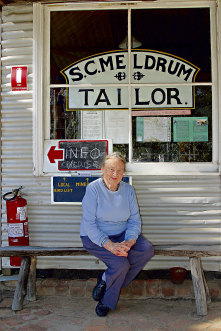
Val Lheude in front of the tailor shop in Yerranderie, 2007.Credit: Bruce Elder
Valerie Anne Lhuede was born on July 1, 1923, to Ren, a World War I veteran, and of Katie Louise, daughter of Samuel Baulch, one of the wealthiest merino sheep farmers of the Western Districts of Victoria.
Valerie had a younger brother, Brian John (John) Lhuede. In the 1930s, when the Great Depression hit, Ren found that the last plot of a subdivision he had done at Beauty Point, Mosman, which he called the Pearl Bay Estate, had not sold at auction. He kept the land and built the family home, moving there in 1942.
As well as volunteering for the war effort, Valerie studied architecture at Sydney University, graduating in May 1947, before joining her father in his business. Ren, a business associate of L.J. Hooker – destined to become a big name in real estate – heard from Hooker that he wanted to dispense with Yerranderie. Thinking he might be able to revitalise mining in the area, Ren formed a company, Tonalli Mining, and purchased the property. Valerie visited the town and was impressed by its beauty, surrounded by the Kanangra National Park.
Silver ore had been discovered in the area in 1871, but its true value was not realised until 1896. A road across the Burragorang Valley was built from Camden, making it possible for mining machinery to be transported, and commercial mining had started there in 1899. A steep rise in world silver prices in 1909 provoked a rush. Sixteen shafts became commercial successes and at its peak, the village had 2000 people, a school, three churches, two butchers, one hotel, a police station, a courthouse and a movie theatre.
But mining slowed and in 1928, when silver prices tumbled, the mine owners cut their losses and ceased operations. Some families stayed on, trapping, hunting and growing vegetables, but Yerranderie became a virtual ghost town.
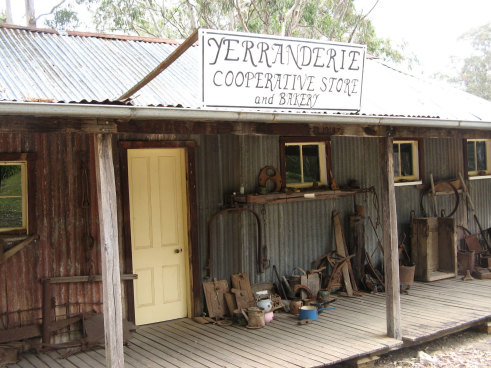
Yerranderie, Blue Mountains.Credit: Sophie Dode
In 1956, Tonalla shareholders, seeing world silver prices decline further, sold the shares to Valerie, who saw it as a potential tourist destination. Three years later, Sydney Water flooded the Burragorang Valley as part of the completion of Warragamba Dam, and that cut direct access from Camden to Yerranderie, leaving the only land access as the difficult Oberon-Molong stock route. Valerie took court action to argue for compensation and was awarded £3000. The fight to preserve Yerranderie for future generations became her lifelong passion.
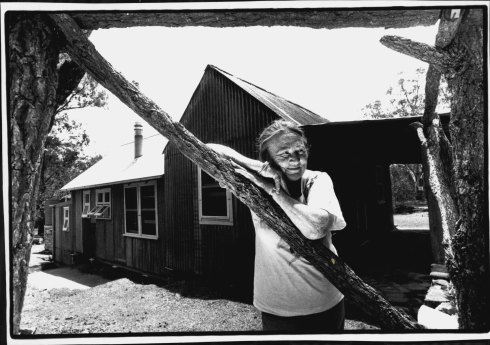
Val Lhuede in the old mining town in 1994.Credit: Steven Siewert/Fairfax Media
In her other life, Valerie was an inveterate traveller and talented photographer, selling her photos to magazines, and for postcards and calendars. After attending her brother John’s wedding in 1949, she took to travel, first visiting England. In 1955 she took a cruise to the Pacific Islands, earning her passage by taking photographs. She would follow that in succeeding years with trips to Thailand, Vietnam, Cambodia, Japan, the Americas, Scandinavia and Russia, Iran and China, Egypt and France.
When her father died in 1965, Valerie moved from the family home into a houseboat he had given her in 1960. With silver prices rising, a Canadian company became interested in developing the Yerranderie mines and sent geologists there, Lhuede fitting out the old two-storey wooden post office to accommodate them. But within a few years, investors lost interest. She continued with her tourism venture, sympathetically restoring the buildings.
The post office became “The Lodge”. Other buildings included the corrugated iron tailor’s shop and Mrs Barnes’ boarding house, a one-roomed slab cottage with a crude kitchen extension. Lhuede was to invest a million dollars in Yerranderie.
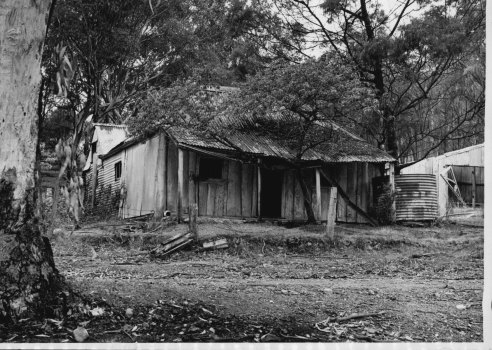
Mrs Barnes’ boarding house in the main street of what is left of Yerranderie Village, 1972.Credit: Fairfax
One-time marine engineer John Hopwood stumbled across Yerranderie and was delighted, describing the town as “like some apparition from last century’s gold rush … Here were kangaroos resting in the shade of a wonderful old post office, a goanna stalking along the veranda of a settler’s home, parrots everywhere and an emu striding across the town common.”
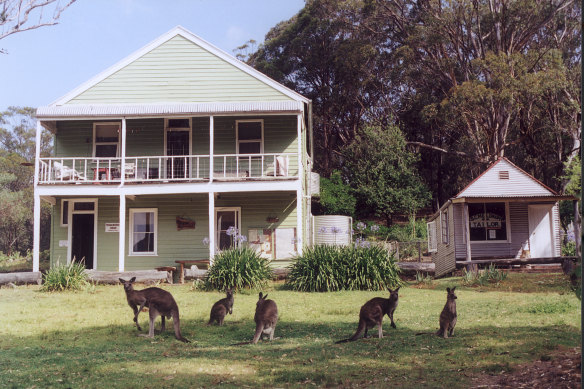
The Lodge and kangaroos in front of the historic post office, Yerranderie.
Hopwood became a caretaker, one of many over the years, while Lhuede split her time between the town and her houseboat, and later her apartment in Kirribilli. She developed an airstrip at Yerranderie, and many of her patrons were flown in from Camden and The Oaks airports.
In 1994, Herald journalist John Huxley wrote that Lhuede was “a remarkable woman who describes herself as ‘a little old woman living in the middle of nowhere’.”
Lhuede said: “This has been my passion, my life. It has always been my vision to make Yerranderie a centre for what is now known as ecotourism. I’d travelled the world taking photographs … and just loved ecological tourism where you learn something. I decided that’s what Australia needed and when I found Yerranderie, everything fell into place.”
Lhuede studied the career of the French explorer Francis Luis Barrallier, the first European to visit the area. This expedition, along with her interest in the local Aboriginal people, inspired Lhuede to write a book of fiction, Yerranderie, My Dreaming, published in 2007. She followed that with The Sunrise of Aboriginal Art in Capricornia Country, featuring stories and descriptions of the Aboriginal artists she had met. She donated the artworks and artefacts she had collected, via the Blue Mountain World Heritage Institute, to the Gun-dun-Gurra Indigenous people of Katoomba.
In 2011, she decided to hand the estate to the National Parks and Wildlife Service. Awarded an AM in 2010 for her contribution to environmental conservation, Lhuede, and her legacy, is remembered in many ways, including events in 2019 when the airstrip she had developed played a critical role in fighting the Black Saturday bushfires.
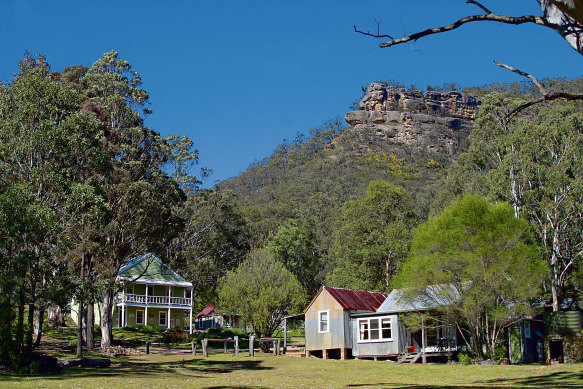
Yerranderie village, 2007.Credit: Bruce Elder
In 2018, she published Valued Memories of a Happy Life. In the NSW Legislative Assembly in September 2023, MP Felicity Wilson said: “I want to recognise Kirribilli local Valerie Lhuede. I want to wish Valerie a very happy birthday as she celebrates her 100th birthday. On September 27 this year, Valerie Lhuede died at the age of 101. She is survived by six nieces and four nephews, and dozens of great- and great-great nieces and nephews.
Valerie Lhuede’s funeral will be held at St Mary’s Catholic Church, North Sydney, on October 10. Her ashes are to be scattered at Yerranderie.
Start the day with a summary of the day’s most important and interesting stories, analysis and insights. Sign up for our Morning Edition newsletter.